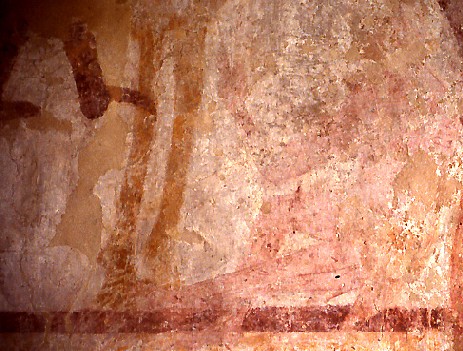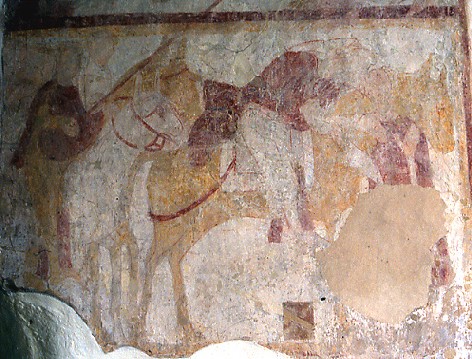Wareham (St Martin’s), Dorset (†Salisbury [Sarum]) C.12
St Martin Dividing his Cloak

The story of St Martin and his charity towards the naked beggar he encountered is told in several scenes on the north wall of the chancel at Wareham. The saint is first pictured riding out with companions, one of them (not shown here) holding a lance , and the detail at the right shows the moment of the encounter. The vertical dark yellow lines to the left of centre are the front legs of St Martin’s horse, and the dark red areas further to the left represent Martin’s own legs in their stirrups.
The beggar, seated on the ground, takes up the right-hand side of the scene. His pink form is very indistinct, but his raised right arm, bent at the elbow as he extends his hand upwards for alms, and his legs, the right with knee raised, the left outstretched flat along the ground, will emerge with patient scrutiny. His right leg, at ankle height, actually crosses the red horizontal border of the scene, and there is a hint of ragged draperies. It is an oddly relaxed, even casual, pose, especially when contrasted with the rather stiff and conventional articulation of the other figures in the series.

The narrative continues in a lower tier, and the episode at the left shows the central detail of Martin dividing his cloak to share with the beggar.
At the left, the mounted man with the lance referred to above appears again, along with a second man on a yellow horse beyond him and possibly a third behind them.
In the centre of the picture, very faint but painted on a larger scale than these attendant figures, is St Martin himself, also riding a yellow ochre horse.
He is in the act of cutting the cloak in half, and this appears as a dull red irregular shape spread across his body at waist level. Spanning the horizontal border at the top of the scene, what appears to be his head is very faintly visible and may have a halo; the square shape of his saddle-cloth is clear, and the outline of his right leg extended downwards across it can be made out. Details at the right-hand edge of the episode are very hard to see, but they may show Martin’s broad-bladed short sword (just above the patch of repaired plaster) held out at a downward angle as if completing the act of slicing the cloak. In front of the horse’s neck, very faint and partly obscured by the repaired area, is what appears to be a standing figure, very possibly the beggar now wrapped in his half of the cloak. Further east on the wall some scattered fragments – a disembodied left hand, a crown – may be the remains of the last episode in the narrative, in which Christ, wearing the cloak, appeared to Martin in a dream.
There is one other example on this site of St Martin dividing his cloak, at Chalgrave in Bedfordshire, and one or two others will, I hope, be on the site eventually. The Wareham version, though, is the earliest by far. It is a great pity that the figure of the near-naked beggar is in such a dilapidated state, because I suspect it may originally have been quite a remarkable example of an unclothed figure; what is left hints at a rounded, sculptural articulation of the human form not normally found in painting before the Renaissance.
There are a few other painted fragments, none of them identifiable, in the chancel at Wareham. The chancel arch wall itself is a palimpsest, with the remains of layers of decorative painting and inscriptions from various dates. The earliest of these layers may be even earlier than the St Martin painting, since the present church dates from around 1020, although the original foundation is generally credited to St Aldhelm (639-709), a great builder of churches in this part of Dorset.
Website for St Martin on the walls, Wareham